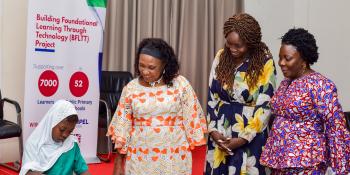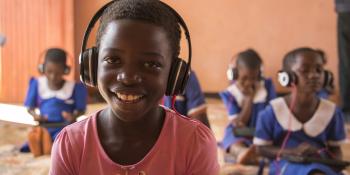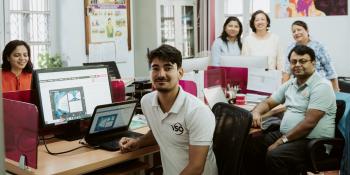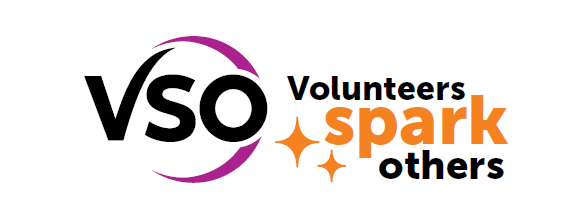Building Foundational Learning Through Technology in Sierra Leone: Highlights from the research findings
Sierra Leone's education system faces a range of persistent challenges, including a shortage of trained teachers, limited resources, and widespread poverty. These issues are particularly acute in Pujehun, one of the country's most marginalised districts, where 83.6% of its residents live in multidimensional poverty, and over half of the population is deprived of basic educational and developmental opportunities.
The Building Foundational Learning Through Technology (BFLTT) project aimed to address these challenges and improve foundational literacy and numeracy for young learners in Class 1–3. Led by VSO, partnered with EdTech Hub and funded by the Hempel Foundation, this initiative ran from October 2023 to July 2024 and brought innovative EdTech solutions to classrooms in Pujehun.
Learners used the onebillion onecourse software through three learning modalities: standard (one-tablet-per-learner), tablet-sharing, and whole class projector in both English literacy and numeracy in school.
Project impact
Students reached, including 2,473 girls, 2,028 boys and 24 students with disabilities.
Community members engaged, including 484 women, 572 men, and 30 persons with disabilities.
Teachers trained to deliver the intervention, including 45 female and 80 male teachers.
About the research
Objective
Evaluate the effectiveness and cost-effectiveness of three implementation modalities for onecourse: standard (one-tablet-per-learner), tablet-sharing (one tablet shared by two learners), and projector (whole class). This intervention was conducted over 12 weeks across February to July, with 5 sessions weekly across 24 schools.
Methodology
Data sources such as teacher surveys, classroom observations, school visit memos, implementation journals and student assessments were gathered to monitor fidelity and evaluate progress. A quasi-experimental Difference-in-Difference approach was used to quantitatively understand changes in baseline and endline assessment scores. Qualitative data, including interviews, were analysed using a hybrid of deductive and inductive coding to identify key themes to inform contextual understanding.
Cost-effectiveness analysis
Benchmarks including cost-per-child and Learning-Adjusted Years of Schooling (LAYS) were used to assess each modality’s cost-effectiveness.
Our findings
The study's findings indicate that the intervention, applied in three distinct modalities: standard, tablet-sharing, and projector, significantly improved literacy and numeracy learning outcomes for primary school students.
Comparative effectiveness of modalities
All three intervention modalities proved equally effective in improving literacy and numeracy skills compared to the control group (no intervention), with no statistically significant differences between them. While improvements were observed across the board, the analysis revealed that these interventions helped lower-performing students catch up with their higher-performing peers.
Specifically, students with initially lower literacy skills showed the greatest improvement in the standard modality. However, higher-performing students benefited more from the whole-class projector approach, indicating that the different modalities benefited students to varying degrees based on their initial literacy and numeracy levels.
Overall improvements: Students showed greater improvement in early grade reading assessment (EGRA, literacy) scores (39% to 42%) compared to early grade mathematics assessment (EGMA, numeracy) scores (29% to 33%) across all modalities.
Effect sizes by modality:
- EGRA: Highest effect size with the projector modality (2.44 Standard Deviation/SD), followed by standard (1.97 SD) and tablet-sharing (1.82 SD).
- EGMA: Smaller effect sizes, with tablet-sharing (1.61 SD) leading, followed by standard (1.48 SD) and projector (1.26 SD).
Ceiling effect in numeracy (EGMA): A total of 47 out of 212 learners achieved full marks at endline, potentially limiting further measurable progress for these students in the study.
It is also important to note that the learners’ initial literacy and numeracy levels were very low, with students scoring an average of 4.93 out of 62 and 12.03 out of 47 for EGRA and EGMA respectively at baseline, potentially contributing to the large effect sizes observed from baseline to endline.
Gender equity in learning outcomes
An important finding is the intervention’s potential to reduce gender disparities in learning. In the intervention schools, boys and girls performed equally well across literacy and numeracy. In contrast, in control schools, boys outperformed girls in numeracy, with the gender gap widening significantly by the end of the study.
Despite this positive finding, qualitative data from the standard and tablet-sharing modalities suggested that the usage of EdTech might be gendered in educational settings. Teachers reported that boys tended to pick up new technologies faster than girls, that the boys are more likely to ‘properly use the tablets’ while the ‘girls find it difficult to use the tablet’.
The intervention, however, appears to allow for girls to be less disadvantaged in comparison with conventional teaching methods. Compared to baseline, the significant gender difference in standard modality disappeared at the endline, suggesting the intervention might have equalised the gender gap. This finding signals a promising role for EdTech as an equaliser for gender disparities in learning.
Language use and learning gains
The study also investigated the role of language in learning gains. Teacher surveys indicated that classes conducted in Mende compared to Krio or English showed slightly more improvement from baseline to endline, across both intervention and control groups. Although this correlation was not statistically significant, it hints at the importance of home language in effective learning.
This finding shows the potential benefits of the current classroom language policy mandated by the Ministry of Basic and Senior Secondary Education of Sierra Leone where the mother-tongue of the learners or the language most widely used in the local community shall be the language of instruction in classes 1-3.
Further research is needed to determine the impact of mother-tongue education in this context and more support for teachers in the use of these languages is also needed to ensure teachers are equipped with the required linguistic knowledge.
Challenges
The challenges encountered in this study reflect the realities of EdTech implementation and research in schools in most LMIC contexts, where schools are dynamic environments and interventions must adapt to diverse conditions and needs.
Implementation fidelity proved to be a major challenge, with some schools and classes not implementing the intervention as intended, potentially impacting the reliability of the findings.
The qualitative data indicates that student-to-tablet ratios in both standard and tablet-sharing modalities shifted due to increased attendance and enrolment, forcing teachers to adopt creative strategies for classroom management. For instance, some schools in the standard modality may have allowed learners to share tablets when there were not enough tablets for each learner present in school. Meanwhile, some tablet-sharing schools allowed individual tablet use.
Both the implementation and research have also faced delays caused by a range of factors such as procurement, weather, political events, holidays, and school calendar changes, which required communication, flexibility and adaptation from the team.
Future directions
Future research should focus on enhancing programme effectiveness by strengthening teacher training and support. Ensuring teacher attendance at training sessions and implementing strategies to boost student attendance and enrolment rates will also be essential.
Incorporating scaffolding in students' home languages into teacher training and teaching, with ongoing support provided as part of programme monitoring, will further enhance the learning outcomes.

Learn more

Building Foundational Learning Through Technology
Working in partnership with the Government of Sierra Leone, the Building Foundational Learning through Technology (BFLTT) project in Sierra Leone is using ed-tech to enhance learning in remote regions.

Using technology to deliver high quality education
Addressing global education challenges with award-winning technology.

Research and evaluations
Transforming evidence into knowledge for impact.
